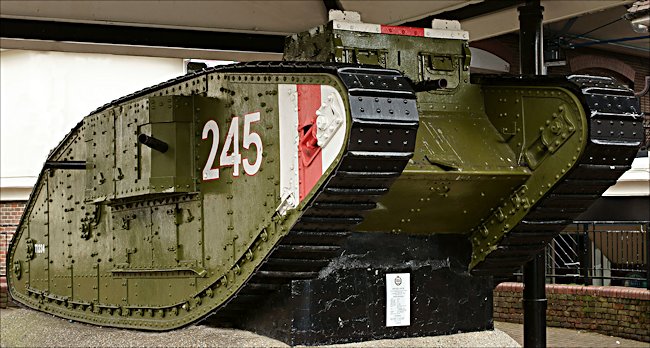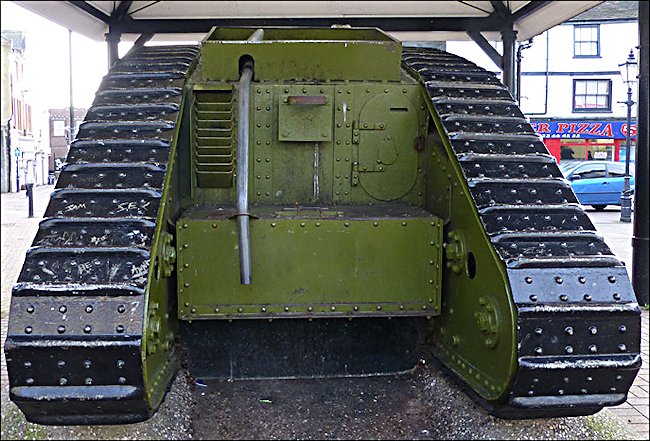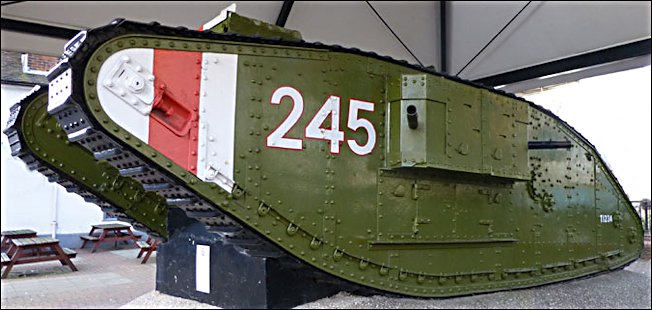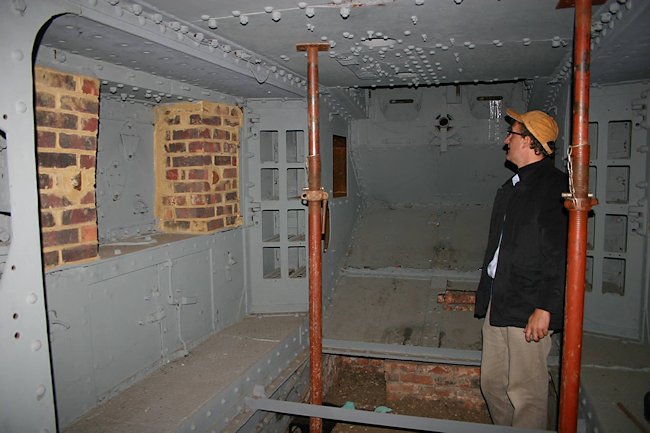Mark IV Female Tank
This WW1 British Mark IV Female tank can be found in Ashford, Kent, England. It has been placed under a canopy in the centre of the city amoungst the shops.

WW1 British Mark IV Female Tank
Why was the British Mark IV Female tank only armed with machine guns?
When I first learnt that a World War One British Mark IV Female Tank did not have a main cannon with which to defend itself, only four machine guns, I thought that was extremely silly. But I was viewing the situation from a WW2 and modern warfare perspective where other tanks were the enemies.
This was not so in the muddy shell hole deformed battlefields of 1914-1918. The enemy they were designed to supress were machine gun posts and rows of barbed wire which the infantry soldier had problems over coming. The Mark IV tanks could still cross trenches that were 11.5ft (3.5m) wide just like the older Mark I tanks. As they crossed the trenches the tank gunners would rake the enemy positions killing every German soldier within range.

This WW1 British Mark IV Female Tank can be seen in the middle of the town of Ashford in Kent.
The armour plating on the side of the tank enable the tank crews to get close to enemy strong points hiding behind sandbags and trench systems. The large tracks could breakdown most barriers in their way and enable supporting infantry, hiding behind their protective metallic bulk to jump into those trenches and assault the German troops manning those defences, with hand grenades, bullets and bayonets.
Normally two Mark IV Female Tanks would be posted to a Mark IV Male Tank. It was machine guns at close range that were needed on a WWI battlefield not howitzers. Most of the time their targets were enemy infantry soldiers not other tanks. If the tanks did breakthrough the German trench system and got into the rear defences they could use both machine guns and their main cannon on the Male tank to destroy enemy artillery.
There are reports of Mark IV tanks running over German guns to destroy them. The Female tank was not as defenceless as many think. It had an eight man crew and weighed 25.3 tonnes (27.9 tons). Its power to weight ratio was 3.7bhp/ton which was the same as the Mark I tank but the Mark IV was a little bit lighter.

This WW1 British Mark IV Female Tank can be seen in the middle of the town of Ashford in Kent.
Surprisingly the Mark IV tank was shorter than the 9.9m (32.5ft) length of the Mark I. It was only 8m (26.2ft). Why is this surprising? After the first tank assaults by the Mark I British tanks in 1916 the German response was to widen their trenches to form a tank trap.
You would think that the logical thing for the British tank designers to do was to increase the length of all future tanks so they could cross these wider trenches. What they did instead was come up with a way of breaching these wide trenches.
They looked at the past for inspiration. When knights in armour has to cross a moat or defensive ditch to get at the enemy fortifications they used bundles of faggots: tree branches cut to the same length bound together with rope. These bundles were rolled into the moat until the formed a temporary causeway capable of taking the weight of a man and his siege engines. The WW1 military term for these bundles was a ‘fascine’.
This is what the British did. They fitted rails on top of their Mark IV Tanks and secured very large bundles or wood on top. As they got to the edge of the trench the securing straps were released from the safety of the inside of the tank. The faggot of sticks rolled forward into the ditch. The tank then got out of the way to enable the next tank to deliver its load. This went on until the ditch was full of wood bundles. The British tanks then simply drove over the top and forward onto the enemy’s rear defences.
There had been some improvements in the tanks design from the Mark I tank. Production commenced in March 1917. Field Marshal Haig, British Commander wanted to have hundreds of tanks available so he could send them into battle in large numbers. He wanted to force a breakthrough wide enough to send whole infantry divisions in after the tanks not just a single regiment.
Production delays meant that it was only in November 1917 that there were enough Mark IV Female and Male Tanks available. The first large scale mass attack of armoured tanks happened at the battle of Cambrai 20th November 1917. The British were able to field 378 Tanks.
The Mark IV Female and Male Tanks took part in nearly every battle on the British sector of the European WW1 Western Front from September 1917 until November 1918. When the British Mark V tanks started to arrive in 1918 many of the older Mark IV tanks were relegated to armoured supply tanks. They could carry 5 tons of stores, which was sufficient to resupply five tanks on the battlefield. This saved the Mark V tanks having to return back to their depot once they had run out of ammunition or because their fuel tank was nearly empty.
The Ashford Mark IV Female tank
Ashford's tank was built in 1916, but it is believed it never saw active service. The tank was presented to the Town on 1 August 1919 by Captain Ferrar of the Army Council, in recognition of the splendid response to the National War Savings Appeals. The Tank was delivered to Ashford West Railway Station (Off Godinton Road) and was driven to St George's Square.
Sadly, in 1929, the back of the tank was removed, as well as all the mechanical workings inside, and an electricity sub station was installed inside the tank. However, this probably saved the tank, as many were either scrapped as they became forgotten relics between the wars, or were melted down for the war effort of World War Two. The electricity sub-station was closed in 1968.
In 1978 and ten years later in 1988 The Royal Electrical and Mechanical Engineers REME carried out some minor works to the tank, including replacing the guns and painting the tank in its original colours. A canopy was built over the tank to protect it.
In 2005, the Council commissioned a local engineer (Mr Keith Williamson) to carry out major refurbishment of the tank. The Tank Museum at Bovington was very helpful and allowed Mr Williamson access to their tank in the museum, and supplied a number of drawings showing all the dimensions of the tank.
The refurbishment included removing all of the rust from inside the tank, and repainting with a rust inhibitor, bracing the sides of the tank (as it has no floor), repairing any cracks in the structure, refabricating a complete back end which is a complete replica of the original tank, and repainting the tank.
The tank is a Registered War Memorial (Reference No 43725), it was rededicated prior to Remembrance Day 2006, in the presence of Damien Green, the British Legion, representatives of the Council and the engineers who completed the work.

The interior equipment and fittings of this WW1 British Mark IV Female Tank at Ashford in Kent were removed so that an electricity sub-station could be built inside the tank. When it was closed in 1968 the electrical equipment was removed leaving an empty space. It was the fact that it was used as an electricity sub-station that saved the tank from being cut up for scrap metal. (Photo - Weald Foundation)
Where can I find other preserved Mark IV Tanks?
- Mark IV Male - Tank Museum Bovington, England
- Mark IV Male - Royal Museum of the Armed Forces, Brussels
- Mark IV Female - Museum of Lincolnshire Life, Lincoln England
- Mark IV Female - Ashford, Kent, England
- Mark IV Female - Flesquières, France
- Mark IV Female - Australian War Memorial, Canberra, ACT, Australia
- Mark IV Female - National Armor and Cavalry Museum, Fort Benning, GA, USA
- Source - Pierre-Oliver Buan - http://the.shadock.free.fr/Surviving_Panzers.htm
WW1 Tank books

